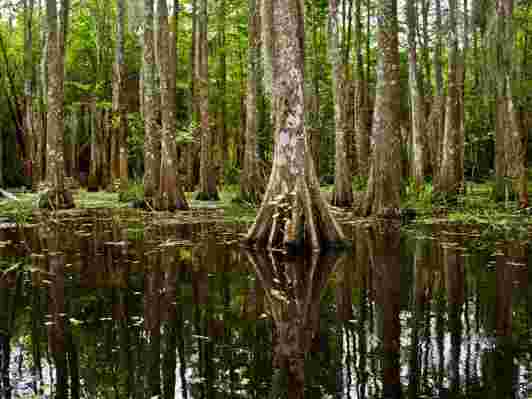A bayou is a slow-moving creek or a swamp y section of a river or a lake. They are usually found in flat areas where water collects in pools. Bayous are often associated with the southeastern part of the United States. Bayous are usually shallow and sometimes heavily wooded. They can be freshwater, saltwater, or a combination of both. This combination is called " brackish water ." Bayou vegetation ranges from tiny mosses to huge cypress trees. Bayous provide habitat for animals as diverse as shrimp, wading birds, and alligators. Bayou Bartholomew is the longest bayou in the world and is located in the U.S. states of Arkansas and Louisiana. It is about 603 kilometers (375 miles) long and contains more than 100 different species of fish. Before railroad lines were constructed in the late 1800s, Bayou Bartholomew was an important waterway for transportation . Houston, Texas, one of the largest cities in the United States, was founded near Buffalo Bayou. The bayou is still important to the city because it serves as a drainage basin for extra water during heavy rains. In this way, the bayou protects Houston from flood ing. Bayou Country The bayous of the American Gulf Coast have a nickname: Bayou Country. Native American s have lived in Bayou Country for more than a thousand years. Many Choctaw people, for instance, are native to Bayou Country. Choctaw people relied on the rivers and bayous of the Gulf Coast for shelter and food, such as fish, shrimp, and birds. They developed sophisticated watercraft to navigate between seasonal settlements. Wooded bayous also provided protection during times of conflict. Today, many Native Americans retain close ties to Bayou Country. The United Houma Nation, native to southern Louisiana, has the crawfish as its official emblem, for instance. A group of Atakapa-Ishak people live in the "water village" of Grand Bayou. Most homes can only be reached by boat, and the community's most important economic interests are fishing and shrimping. Bayou Country is also home to Cajun and Creole cultures. Cajun s trace their ancestors to French-speaking people from the southeastern part of Canada called Acadia . (Today, Acadia is a region that includes part of Quebec and Canada's " Maritime Provinces" of New Brunswick, Nova Scotia, and Prince Edward Island.) In the mid-1700s, Acadians were forced out of their homes as the British took control of the region. Many Acadians migrated to the isolate d bayous of Louisiana. Here, they preserved elements of their culture . Today, more than a dozen parish es in southern Louisiana are part of "Acadiana." Cajuns speak a version of French (Cajun French) and have a unique musical heritage drawing on French and Canadian folk tunes. Like Cajun culture, Creole culture has its roots in migration and re-settlement. In the early 1700s, "Creole" indicated a European person born in Louisiana, then a colony of France. Soon, Creole was used to describe a mixed-race person from the region —someone with European, Native American and African (often slave ) ancestry . In the 1800s, Creoles achieved power and property rights rare for mixed-race people in the rest of the United States. Bayou Country's Creole culture is a rich collection of diverse influences. The music most associated with Creole culture is zydeco, a mixture of American jazz, Cajun folk, and African rhythms. Food, such as gumbo, also has African, Native American, and European influences. Both Cajun and Creole cultures are defined by the waterways of Bayou Country. The bayous helped preserve and strengthen Cajun and Creole cultures by allowing the groups to interact with their family and maintain a sense of community . Until the 20th century, bayous along the Gulf Coast and Mississippi River were vital for transportation, communication , and commerce .

